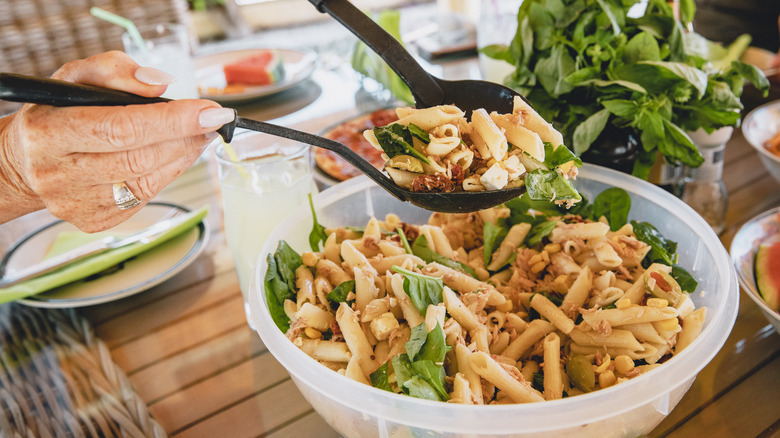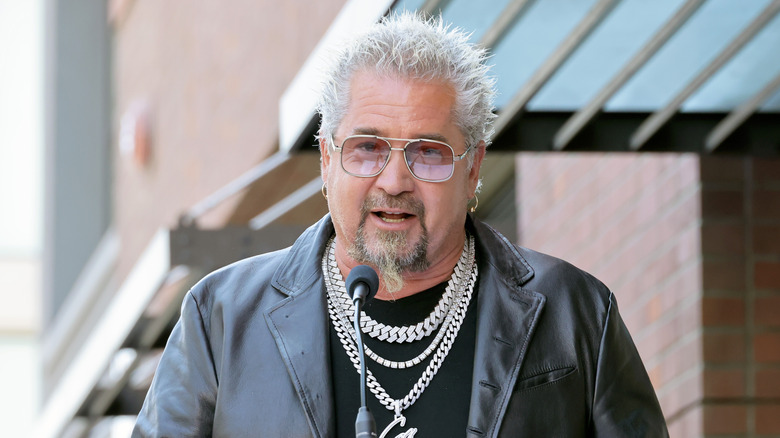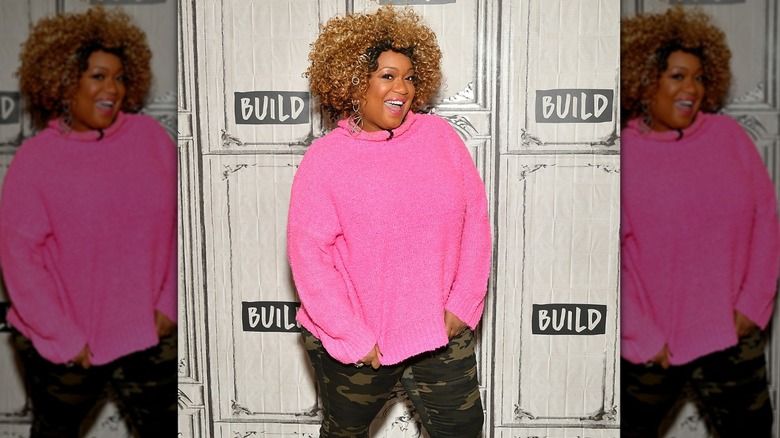11 Celebrity Chef Tips For Elevated Pasta Salad
Celebrity chefs combine their know-how in the kitchen with big personalities, charming smiles, and witty banter on your favorite foodie TV shows that let them bring their best tips and tricks to a wider audience. In the summer months, many add pasta salad recipes to the meal rotation because they combine fresh ingredients with tons of flavor. But these are anything but boring thanks to the secrets that celebrity chefs are more than willing to share, whether it's on camera or in a favorite recipe. Even though pasta salad is a tried-and-true dish to share, these options can take it from a side to the main event.
Unexpected ingredients, prep secrets, and the perfect pasta noodle can make even a humdrum pasta salad side dish the star of your next backyard barbecue. Many of the chef's best secrets require some planning ahead of cooking, such as choosing ingredients that pair well together or toasting nuts to bring out their flavor. These tips include some classic favorites, such as how to create a great dressing or the secret to trying a new or lesser-known pasta shape. Others help you save time or even help you whip up a memorable pasta salad using a secret formula and ingredients you have in your kitchen. Even when sharing other tips, most celebrity chefs noted that adding fantastic ingredients (and plenty of them) can make a simple pasta salad extra special.
Add plenty of ingredients
The Barefoot Contessa, Ina Garten, is no stranger to summer salads, which she made, perfected, and sold at her Hamptons, New York specialty food store. Garten's popular pasta salad includes generous portions of ingredients, including feta, tomatoes, and olives. While some pasta salad recipes skimp on the cheese and veggie goodness, Garten's version has one pound of tomatoes and one pound of feta to only half a pound of noodles. She also includes two types of tomatoes, fresh and sun-dried, for extra depth of flavor. This pasta salad adds flavor at every step, from the chopped ingredients to the dressing, and is Garten's go-to trick to prevent a boring, basic pasta salad.
When demonstrating how to make it, Garten recommended starting with warm pasta. Adding ingredients to warm pasta helps the noodles absorb the flavor. This is especially true of the dressing, which she made from scratch. Garten added sun-dried tomatoes to the dressing, pureeing them in a food processor along with vinegar, olive oil, capers, and plenty of seasoning, as well as in the salad. As soon as she drained the pasta, Garten added the sun-dried tomatoes first, followed by the fresh tomatoes, and olives. She opted to add the dressing, Parmesan, and parsley next before tossing the ingredients together. She doesn't go light on ingredients, which she says helps boost the flavor of pasta salad that would otherwise be boring. She adds salty feta crumbles toward the end of assembly.
Make a flavorful dressing
The dressing is a key ingredient in pasta salad because it impacts the flavor of every bite. Ree Drummond's sunshine pasta salad relies on lemon juice and lemon zest to add brightness to a mayo-based dressing. The dressing is such an important component in her pasta salad that she starts by demonstrating how to make it and shares her trick on making it stick to every bite. Drummond starts by combining equal parts mayo and sour cream. Dijon mustard, lemon zest, and lemon juice give it the bright flavor that makes this pasta salad stand out. She also adds grated garlic, salt, and pepper, which bring out the other flavors in the dressing.
Unlike some other chefs who advocate for adding dressing to warm pasta, Drummond adds hers to pasta that has already had a chance to cool. She only adds around two-thirds of the dressing that she prepared. Drummond says that this allows her to mix up the entire pasta salad and then have more dressing to add to adjust as needed.
Like many other chefs, Drummond recommends being generous with ingredients. In her sunshine pasta salad, she uses red, orange, and yellow veggies, including bell peppers and halved cherry tomatoes, to bring in some visual interest along with delicious fresh taste. She finished this pasta salad with a lemon garnish that fits in with the sunshine theme and gives a nod to the lemony dressing.
Use interesting pasta shapes
Giada De Laurentiis is all about the pasta when it comes to choosing the right ingredients to make a delectable pasta salad. She uses interesting pasta shapes and colors to add interest to her pasta salads, such as the fusilli noodles in her tricolor pasta salad. These spiral-shaped noodles provide consistency in their shape but visual interest because they come in yellow, orange, and green. This doesn't change the taste but does provide something fun and unexpected in the dish. Adding tomatoes, cheese, basil, and arugula, De Laurentiis recommends coating the entire dish with dressing and mixing generously to ensure every noodle and add-in is coated. She also adds a quick grate of Parmesan cheese immediately after draining the pasta to help the sauce and dressing stick to it better.
Noodles with a lot of groves hold extra dressing and ingredients in every bite, another pasta trick that can elevate your salad from basic to outstanding. De Laurentiis' picnic pasta works with any short pasta, such as fusilli, elbow, or the less common casarecce because these shapes hold dressing and incorporate well with other ingredients. Short pasta is also easier to eat with a fork and allows you to get other ingredients in each bite along with plenty of dressing. It is this combination that makes pasta salads work so well.
Mix the dressing thoroughly
Rachael Ray recommends using a food processor to make sure everything is incorporated when making your dressing. The last thing that you want is a bite of dressing that doesn't include key flavors or has all of the garlic, onion, or spice in one spot. In her Italian pasta salad, Ray begins with vinegar and vegetable broth as a base along with grated garlic and chopped parsley. As it goes around in the food processor, Ray adds olive oil in a steady stream as it pulses. Adding the olive oil slowly helps it emulsify, or mix, thoroughly. Oil and vinegar do not naturally mix and tend to separate if you don't emulsify them slowly. This is where the careful dressing process is key.
Even in her pesto penne pasta salad, Ray focuses on getting every noodle coated with decadent pesto dressing full of bright herbs, lemon zest, garlic, cheese, and toasted pine nuts. Like in other dressing recipes, she streams in olive oil slowly to the food processor as she prepares the pesto, making sure that it incorporates evenly.
Roast peppers for extra flavor and tenderness
In her whole wheat pasta salad, Alex Guarnaschelli roasts red peppers over an open flame before chopping them and mixing them into the dish to add extra sweetness and texture to the already delicious mixture of ingredients. In her version, she uses red bell pepper but it works with yellow, orange, or green peppers as well. Charring them over an open flame also brings out the natural sweetness of the bell peppers. You can customize the amount of char by adjusting the time they spend over the flame.
To char peppers, place them directly over the flame of your gas stove. You can also use a grill or fire. The skin will blister and turn black as they cook so rotate the peppers often, ensuring that each side gets equally charred. Take it off the flame and put it on a plate to cool once it is cooked to your preference, which might take a few times to perfect. Once the pepper has cooled, cut it open and remove the seeds. Guarnaschelli recommends removing the black charred bits by wiping the peppers with a kitchen towel, although she also likes to leave just a bit of char to give the pasta salad a touch of subtle crunch and extra flavor. The flavorful pepper will be tender but still crispy, making it the perfect addition to your pasta salad once it is sliced or diced and tossed together with your other ingredients.
Think outside the pasta box
Bobby Flay uses couscous, a small handrolled pasta, as an alternative to traditional pasta shapes like penne or macaroni in his pasta salad. It works to bring an unexpected twist to other pasta salad recipes and works with a variety of flavors. Couscous cooks quickly, although the most traditional preparation methods can be a lot of work, and creates a fluffy base for your pasta salad. Because of its small shape, it mixes easily with the other ingredients as well. You can add ingredients to give it extra flavor and easily coat the entire dish with dressing, although be careful not to overdo it or you'll end up with a runny mess. Flay adds grilled vegetables and fresh mozzarella to get the perfect pasta salad mixture and recommends giving the vegetables a rough chop before adding them so that they add texture to the dish.
There are multiple styles of couscous but the main characteristic is that these are small, rolled pasta shapes typically made of wheat or barley. Moroccan couscous is the smallest of the three most common varieties and works as a base for dishes that would normally be served over rice. Israeli couscous is also known as pearl couscous because its shape resembles a pearl. Its slightly larger shape makes it perfect for cold salads. Lebanese couscous is a bit larger than pearl couscous but still small enough to mix well and also works well for pasta salad.
Use vinaigrette dressing
Mayo-based dressings might be the first thing you think of when imagining pasta salad so a vinegar-based dressing can be an unexpected and welcome change from the norm. Geoffrey Zakarian uses vinaigrette-based dressing rather than heavier mayo to lighten things up in his pasta salad. The dressing combines vinegar and mustard as a base with grilled scallions, salt, and pepper bringing in some extra flavor. Zakarian grills the scallions until they are slightly charred, then chops them and adds the pieces to the dressing. He adds cooked pasta directly to the vinaigrette before adding any other ingredients to make sure that each noodle is completely coated.
Fresh tomatoes, olives, red onion, and plenty of fresh herbs keep the flavor bright and light. Provolone cheese brings in a bit of creaminess without overtaking the dressing. This is a much lighter pasta salad option than mayo-based salads and it doesn't have the same strict temperature requirements that you face when serving salads with a mayo dressing. However, because it has cheese, you should still store it in the fridge.
Embrace ingredients with heat
Even boring macaroni salad can get an upgrade with extra add-ins that create an entirely new flavor profile to this basic dish. In his appropriately-named mac-daddy-roni salad, Guy Fieri adds roasted peppers, diced peppers, and pepperoncini as well as a flavorful dressing to create a multi-layered flavor with plenty of heat. Fieri is at home with heat-inducing ingredients, adding hot sauce to his garlic bread and sauteed onions and peppers to his Zing Zang flank steak. If you want to turn up the temperature on your mac salad, try his tip to elevate this dish.
It starts with a dressing that goes above and beyond a simple mayo. It begins with mayo but gets a little extra bite from mustard, vinegar, and garlic, which maintains the creaminess of traditional macaroni salad but takes it to the next level. But things get even more interesting when mixing in the veggies. Fieri adds red onion, roasted red peppers, pickled peppadew peppers, and crispy veggies like carrots and celery. All ingredients are diced or minced to ensure that they meld well together. This combination of crunch, heat, and bite plus the vinegar and pickled peppers add a depth of flavor that just works. This pasta salad incorporates even better when you let it rest in the fridge overnight.
Opt for salad dressing to save time
You can mix up your own dressing with mayo, vinegar, sugar, and seasonings or opt for store-bought salad dressing that already has the perfect combination of ingredients. According to Sunny Anderson, this time-saver makes pasta salad even easier to whip up. Her pea pasta salad uses ranch dressing, which includes flavors of onion, dill, parsley, and garlic. You can make your own homemade dressing, but if you're short on time, the store dressing is a helpful substitute. Plus, a ready-made dressing is versatile and will keep in the fridge for future use on salads or as a dip as well.
Ranch works as a dressing for a cold pasta salad and pairs well with other flavors, such as chicken, bacon, and even cheese. Many pasta salads call for a vinaigrette dressing, either homemade or a store-bought option. For an added boost to your pasta salad, add a little extra dressing after it has chilled and right before serving. This helps remoisten the pasta, which can absorb some of the dressing as it cools. It is even easier to do if you're using a store-bought dressing that is also stored right alongside the salad in the fridge. Plus, if you need a little bit more, you can always run to the store to restock.
Follow a formula
Martha Stewart recommends keeping all pasta salads to a simple formula. Include something fresh, something green, something briny or salty, something acidic, and something creamy alongside the pasta of your choice. She recommends starting with your pasta pick, choosing a noodle that is short over long noodles that can be hard to eat. Dried pasta also works better because it holds up well to the dressing without getting mushy.
This formula helps Stewart make a great pasta salad even when she doesn't have a specific recipe to follow and allows her to use the ingredients that look the best at the market. You can also shop your own pantry and fridge to make use of what you have on hand or customize your pasta salad by following the formula to combine your favorite flavors. The tried-and-true formula is a helpful way to create a new dish for each get-together that takes advantage of a theme, like including ingredients of the same color or from the same region.
Toast nuts to give extra flavor
This prep trick uses ingredients you already have but elevates them by adding a simple step to bring out their flavor. Gordon Ramsay toasts pine nuts before adding them to his orzo pasta salad. You can do this with any raw nuts with many varieties, including almonds, walnuts, and peanuts, available pre-roasted at the store. Pine nuts are a popular option because they naturally have a lot of oil, which results in a rich, nutty flavor when they are toasted. Roasting them on the stove is a great method because you can monitor their progress easily but the microwave and stove are also options.
It only takes a few minutes to toast pine nuts and you should watch closely because they can go from raw to burnt quickly. Ramsay mixes the toasted pine nuts into the salad while the pasta is still slightly warm to let the flavors start melding together. Pine nuts pair well with basil, which is what Ramsay uses in his pasta salad along with an olive oil and Parmesan dressing. Toasted pine nuts and basil also make a delicious combination in Rachael Ray's pesto sauce that she uses for her pasta salad.











